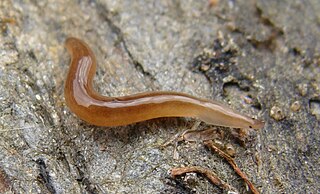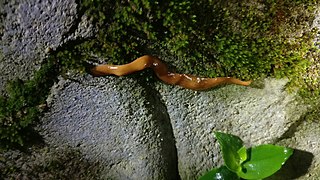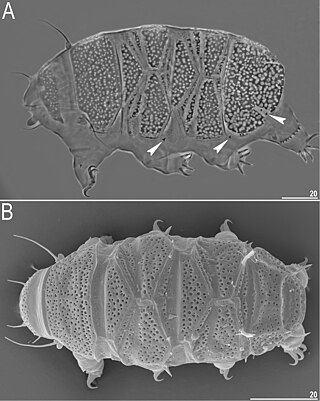
Oroperipatus is a genus of Neotropical velvet worms in the family Peripatidae. Species in this genus are found in South America west of the Andes and in Mexico. Velvet worms in this genus can have as few as 22 pairs of legs or as many as 40 leg pairs. This genus is viviparous, with mothers supplying nourishment to their embryos through a placenta.

Microplana is a genus of land planarians found in Europe and Africa.

Ernst Gustav Gotthelf Marcus was a German zoologist, former occupant of the chair of zoology at the University of São Paulo from 1936 to 1963, and co-founder of the Oceanographic Institute of the University of São Paulo.

Piseinotecus is a genus of sea slugs, aeolid nudibranchs, marine gastropod mollusks in the family Piseinotecidae.
Geoplana is a genus of land planarians from South America.

Eveline du Bois-Reymond Marcus was a German zoologist and drawer.
Oroperipatus bimbergi is a species of velvet worm in the Peripatidae family. The female of this species has 27 or 28 pairs of legs, usually 27; the male has 24 or 25 usually, rarely 26. The type locality is in Colombia.
Oroperipatus bluntschli is a species of velvet worm in the Peripatidae family. The original description of this species is based on a female specimen measuring 100 mm in length; its 40 pairs of legs are notable for approaching the maximum number (43) recorded in velvet worms. The type locality is in Peru.
Oroperipatus corradoi is a species of velvet worm in the Peripatidae family. Females of this species have 26 to 29 pairs of legs, usually 28; males have 24 to 27. Females range from 14 mm to 60 mm in length, while males range from 14 mm to 25 mm in length. The type locality is in Ecuador.

Oroperipatus eisenii is a species of velvet worm in the family Peripatidae. Females of this species have 27 to 29 pairs of legs, usually 28; males have 23 to 26. Females range from 30 mm to 57 mm in length, while males range from 20 mm to 23 mm. The type locality is found in Brazil and central Mexico.
Oroperipatus omeyrus is a species of velvet worm in the Peripatidae family. This species is blackish red on its dorsal surface but lighter and brownish on its ventral surface. The original description of this species is based on female specimens with 24 to 26 pairs of legs and an embryo with 22 pairs of legs. The females range from 16 mm to 22 mm in length. The type locality is in Peru.
Oroperipatus weyrauchi is a species of velvet worm in the Peripatidae family. The original description of this species is based on only two specimens, a male with 40 pairs of legs and a larger female with 38 leg pairs. The type locality is in Peru.

Rhynchodemus is a genus of land planarians in the tribe Rhynchodemini.

Diva Diniz Corrêa was a Brazilian marine zoologist.

Incapora is a genus of land planarians in the subfamily Microplaninae.

The Echiniscidae are a family of tardigrades, a phylum of water-dwelling, eight-legged, segmented micro-animals. It is one of the four families in the order Echiniscoidea. The family was named by Gustav Thulin in 1928.

Echiniscus is a genus of tardigrades in the family Echiniscidae. The genus was named and described by Karl August Sigismund Schultze in 1840.

The Halechiniscidae are a family of tardigrades. The family was named and first described by Gustav Thulin in 1928.
Bryodelphax is a genus of tardigrades in the family Echiniscidae. The genus was first described by Gustav Thulin in 1928.
Mopsechiniscus is a genus of terrestrial tardigrades in the family Echiniscidae. It was named and described by Eveline Du Bois-Reymond Marcus in 1944.











